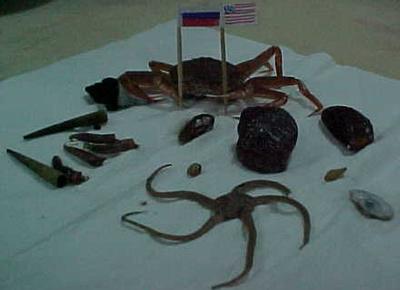22 March, 2001
Tidbit of History
Once Alaska was purchased from Russia in 1867, whalers and fur hunters
wreaked havoc on the marine mammals of Alaska, the primary source of food,
clothing, and tools for the native people. The USRC BEAR under Captain Mike
Healy, began transporting reindeer from Siberia to Alaska in 1891. The
Service continued this mission with numerous cutters until 1906. By WWII,
the herd had grown to over a million. Not only is our service recognized
for saving a starving culture, but also bringing reindeer to the North Pole,
Alaska for Mr. Santa Claus!
Science Observations
Brittle Stars are a member of the echinoderm phylum meaning "spiny body".
They are related to the sea urchin and starfish. Five arms radiate from a
central disc, which contains the mouth and stomach. These narrow arms
generate from a central disc as opposed to sea stars, which don't have
spaces between the arms. Brittle stars can range from a half a centimeter to
12 centimeters.
Brittle stars are basically filter feeders, eating organic materials. They
are carnivorous and use their arms to grab food. Many different feeding
tactics are available to these echinoderms. For example, they can bury
themselves in the sediment, exude a mucus, which traps their food. Their
suction tube feet are used for feeding as well as locomotion. They elude
their stomach to digest food. They may possibly compete with the clams for
carbon.
Echinoderms are unique in the sense that they can be found in every type of
deep-sea ocean from the very warm tropics to the icy cold Arctic and
Antarctic. They don't need any protection from predators.
Some brittle stars are believed to be bioluminescent.
Daily Update
We began our shift immediately being on station. We completed all parts of
the station which included CTD sampling, van Veen, and HAPS core sampling
taking about 3 hours to complete. This was a great way to wake up quickly!
During our second station we found an abundance of brittle stars after we
performed the van Venn grab as well as the HAPS core sampling. When one of
the cores arrived in the lab for sectioning it was filled with brittle
stars. Many had come to the surface outside the sediment in the water.
They were easily seen along the edge of the container.
This afternoon was filled with adventure as Holly and I prepared to go to
the gym for a workout. A muster was piped in and the ship was locked down.
We were trying to decide if we needed to stay in the berth, go to our
emergency location, or continue to the gym. We had been told that the drill
didn't pertain to us, so we headed for the gym. We rounded the corner to
discover the doors closed down. We continued to the stairwell and the hatch
was closed. We opened the hatch and went through the hole in the stairway
not being able to close it. Luckily a Coast Guard crewmember was behind us.
We continued to the gym to discover the Coasties preparing for muster. We
quickly escaped to the laundry room unsure where else to go. We certainly
couldn't return to our room. We didn't need the sauna this afternoon
because we had our own sauna in the laundry room. We stayed in there for
about 35 minutes waiting for the drill to end. Whew! It was pretty funny
afterward.

<> A close up view of a brittle star.

We had a little fun getting artistic in the lab. The USA and Russia unite. Do I teach kindergarten or what????? <>

<> Brittle stars found in the HAPS core chamber.
Contact the TEA in the field at
.
If you cannot connect through your browser, copy the
TEA's e-mail address in the "To:" line of
your favorite e-mail package.
|
